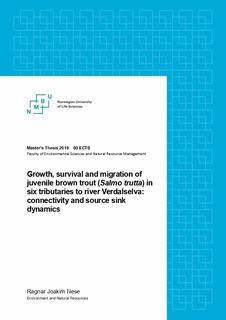| dc.contributor.advisor | Haugen, Thrond | |
| dc.contributor.advisor | Stensland, Stian | |
| dc.contributor.author | Nese, Ragnar Joakim | |
| dc.coverage.spatial | Norway, Nord-Trøndelag, Verdal | nb_NO |
| dc.date.accessioned | 2019-09-04T11:54:29Z | |
| dc.date.available | 2019-09-04T11:54:29Z | |
| dc.date.issued | 2019 | |
| dc.identifier.uri | http://hdl.handle.net/11250/2612485 | |
| dc.description.abstract | Brown trout (Salmo trutta L.) in dendritic river systems mainly use smaller tributaries as spawning- and nursery grounds. The juveniles exhibit territorial behavior and compete over resources of food and shelter. Interactions between density-dependent and density-independent factors influence their life-history traits in intricate ways. Owing to the possibility for inter-tributary movement and inter-tributary variation in habitat quality in such dendritic river systems, survival, growth and migration can be investigated with a metapopulation approach. Differences in habitat quality and juvenile brown trout density among the tributaries may induce migratory behavior and source-sink dynamics. The aim of this thesis was to provide evidence of density-dependent and density-independent differences in growth, survival and migration and reveal source-sink dynamics processes in brown trout inhabiting the river Verdalselva tributaries.
Data was collected by electric fishing and capture-mark-recapture analysis was used to investigate growth, survival and migration within and among six neighboring tributaries to Verdalelva, at four occasions; May, August and October 2018 and in January 2019. Altogether, 1685 juvenile brown trout was caught, out of which 582 were PIT-tagged, 35 recaptured and 101 redetected. Based on previous data, high and low juvenile brown trout densities assigned three tributaries as source and three as sink sub-populations.
Recapture probabilities were generally low, most probably due to difficult fishing conditions (water turbidity, dense vegetation) and due to undetected migration, but there was some variation among the tributaries. As expected, comparing habitat characteristics among tributaries showed significant differences between the source and sink groups. Source tributaries had higher water current velocity and were wider whereas sink tributaries had smaller substrate size and less woody debris. Density estimates of both 0+ and >0+ age classes of juvenile brown trout supported these results and the pre-classification into source and sink groups as the density was significantly lower in sink than in source tributaries.
Sink 0+ individuals were on average larger than source individuals in both August and October, but individuals from source tributaries had higher growth rates (though not significantly so) over the same time span. The estimated monthly survival was negatively associated with juvenile density in the source group but not in the sink group, indicating density-dependent survival in the former. Density-independent effect of drought was found to be most pronounced in the sink tributaries where downstream migration probability increased with decreasing rainfall. The finding of negative correlation between population density and downstream migration probability was not expected and may indicate that density-independent factors overruled density-dependent factors during the warm and dry 2018 summer.
In conclusion, this study has provided results that in varying degree proved useful for enlightening the addressed hypothesis. There was some support for density-dependent survival in source-subpopulations, but no or enigmatic support for density-dependent growth and dispersal. Density-independent survival in sink subpopulations was largely supported and downstream migration was largely density-independent (maybe drought driven). Four individuals migrated between tributaries, which strengthens the hypothesis of source sink dynamics and calls for further research. | nb_NO |
| dc.description.sponsorship | County Governor of Nord-Trøndelag ; Verdal municipality sea trout fond ; NMBU Småforskmidler ; The Norwegian Public Roads Administration ; Norwegian Environment Agency | nb_NO |
| dc.language.iso | eng | nb_NO |
| dc.publisher | Norwegian University of Life Sciences, Ås | nb_NO |
| dc.rights | Attribution-NonCommercial-NoDerivatives 4.0 Internasjonal | * |
| dc.rights.uri | http://creativecommons.org/licenses/by-nc-nd/4.0/deed.no | * |
| dc.subject | Salmo trutta | nb_NO |
| dc.subject | Brown trout | nb_NO |
| dc.title | Growth, survival and migration of juvenile brown trout (Salmo trutta) in six tributaries to river Verdalselva : connectivity and source sink dynamics | nb_NO |
| dc.title.alternative | Vekst, overlevelse og vandring hos ørretunger (Salmo trutta) i seks sidebekker til Verdalselva : konnektivitet og source-sink dynamikk | nb_NO |
| dc.type | Master thesis | nb_NO |
| dc.source.pagenumber | 85 | nb_NO |
| dc.description.localcode | M-NF | nb_NO |

